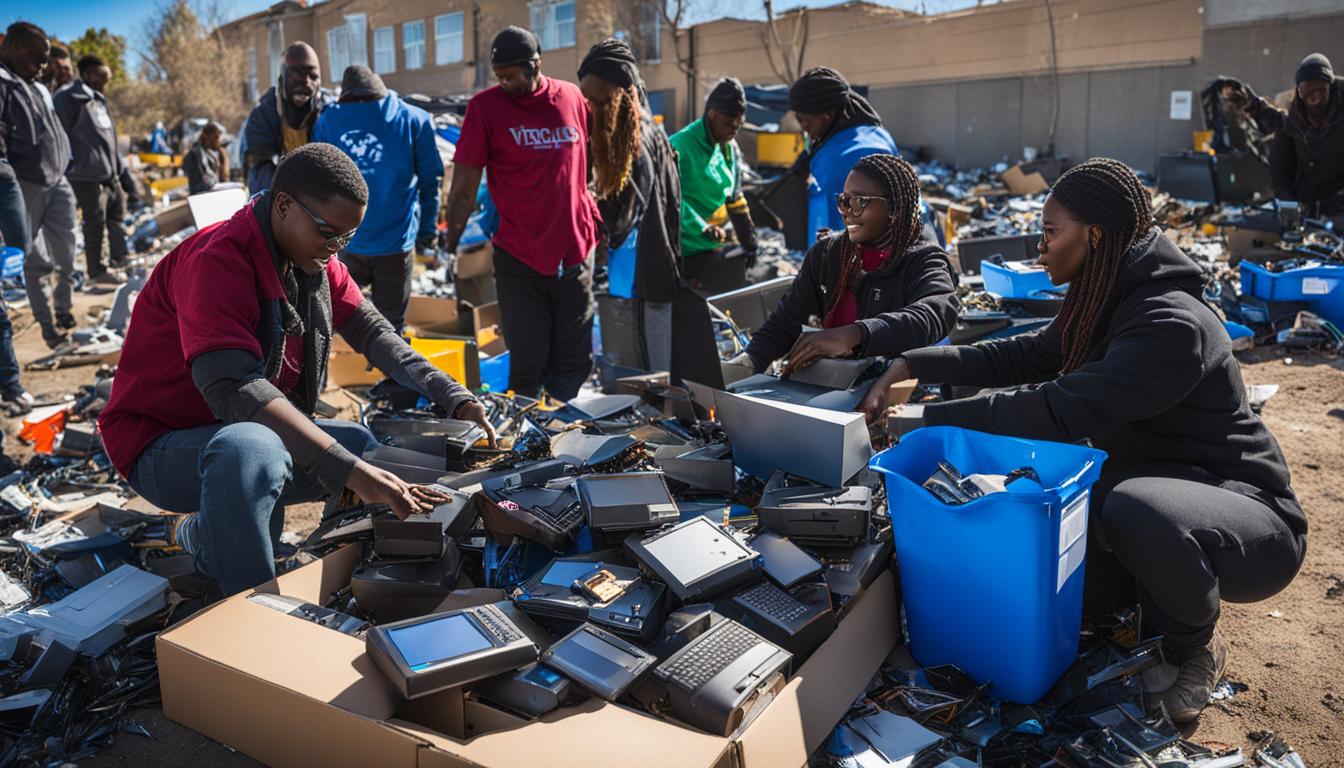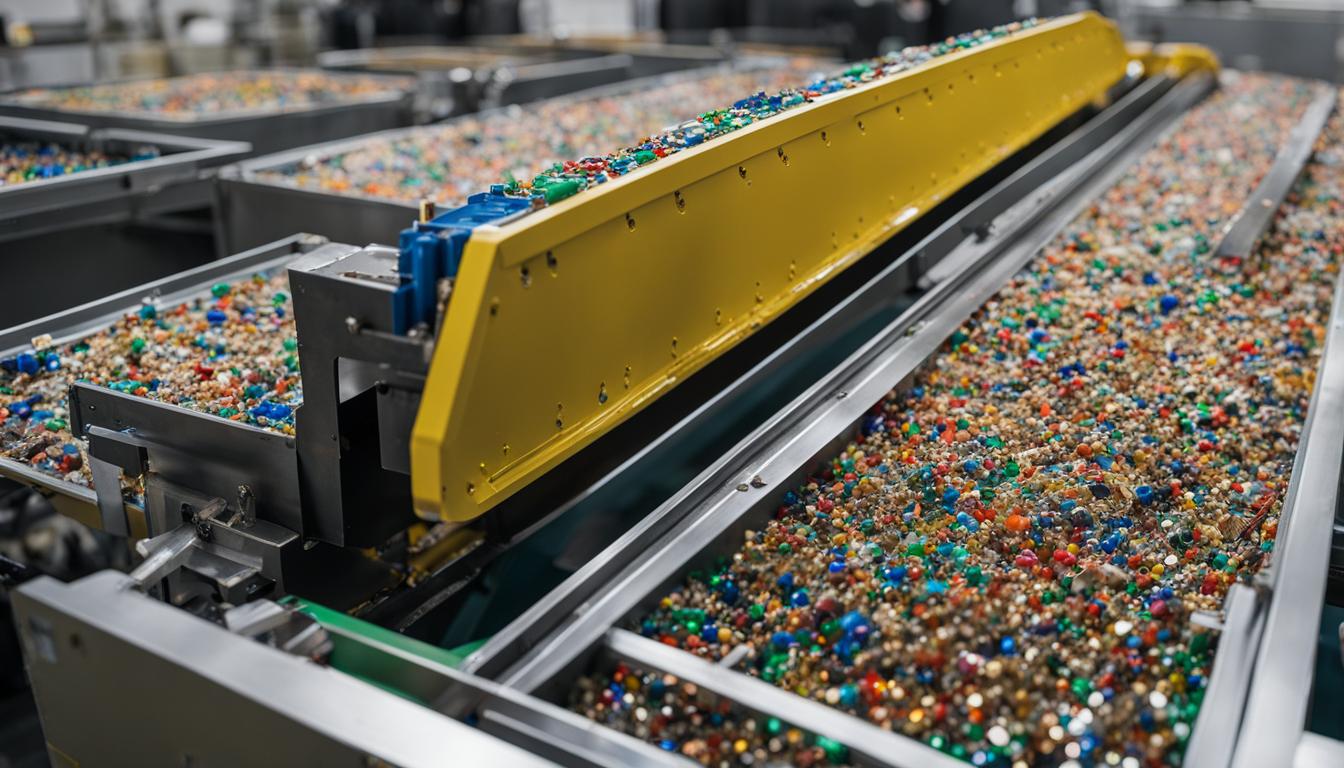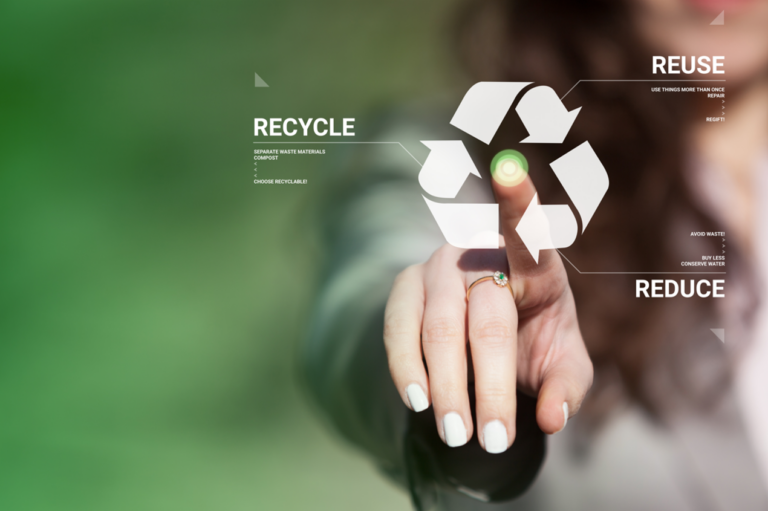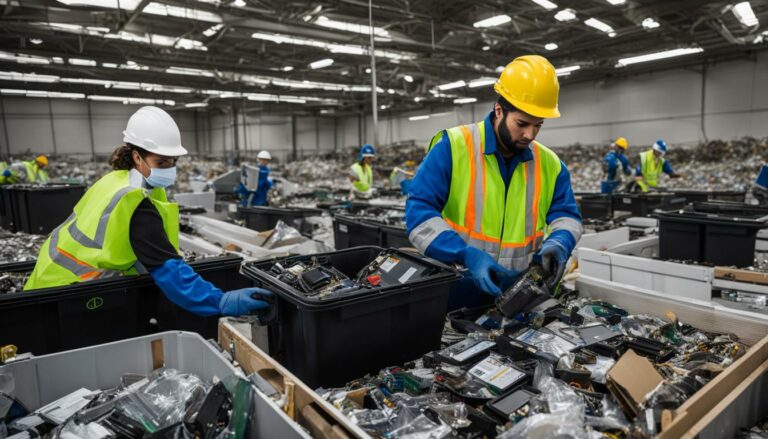IT Recycling in the Age of Cloud Computing
Cloud computing has revolutionized the way businesses store and access their data, but it has also brought about environmental concerns related to IT recycling. The disposal of data storage devices used in cloud computing has contributed to electronic waste and increased the carbon footprint of the IT industry. In this article, we will explore the impact of cloud computing on IT recycling and emphasize the importance of sustainable practices in the disposal of electronic devices.
- Cloud computing has led to an increase in electronic waste and the carbon footprint of the IT industry.
- Sustainable practices in IT recycling are essential to reduce the environmental impact.
- Data security and environmental sustainability need to be balanced in the disposal of data storage devices.
- Sustainable technology, circular economy, and energy efficiency are important concepts in IT recycling.
- Successful case studies and collaborations demonstrate the feasibility and benefits of sustainable IT recycling practices.
The Environmental Impact of Data Storage
Data storage devices used in cloud computing have a significant environmental impact throughout their lifecycle. The manufacturing and production stage involves the extraction of raw materials and energy-intensive processes, leading to greenhouse gas emissions and pollution.
The distribution and retail stage contributes to carbon emissions through transportation, while the usage stage consumes energy, both from the devices themselves and the data centers supporting them. The end-of-life and disposal stage, where most devices are shredded, results in the generation of electronic waste and the loss of valuable materials. These environmental implications highlight the need for sustainable practices in the IT industry.
To better understand the environmental impact of data storage, let’s take a look at the following table:
| Stage | Environmental Impact |
|---|---|
| Manufacturing and production | Greenhouse gas emissions, pollution |
| Distribution and retail | Carbon emissions from transportation |
| Usage | Energy consumption from devices and data centers |
| End-of-life and disposal | Generation of electronic waste, loss of valuable materials |
Source: Own analysis based on industry data
The table provides a clear overview of the different stages of data storage devices’ lifecycle and their associated environmental impacts. It demonstrates the need for sustainable practices to reduce carbon emissions, electronic waste, and the loss of valuable resources.
The Case for Secure Data Destruction
When it comes to the disposal of data storage devices, companies are faced with the challenge of balancing data security and environmental sustainability. Many choose to opt for secure data destruction methods, such as physical shredding, to ensure that sensitive information does not fall into the wrong hands. This is particularly important in an era where data breaches and cyber threats are on the rise.
Data security and customer trust are paramount concerns for businesses in today’s digital landscape. The fear of data leakage and the potential consequences, including financial penalties and damage to reputation, make secure data destruction a top priority. While data wiping software can securely erase data from devices, concerns about potential leaks and compliance with regulations often lead to physical destruction as the preferred method of data disposal.
However, incidents of unauthorized sales of decommissioned servers and hard drives serve as reminders that proper data destruction practices are essential. These incidents not only compromise data security but also highlight the need for companies to be cautious in their disposal methods. By adopting secure and responsible data destruction practices, businesses can safeguard sensitive information while also contributing to environmental sustainability.
The Importance of Regulations and Customer Trust
“Data breaches can have severe consequences, including financial penalties and damage to the company’s reputation.”
Regulations play a crucial role in ensuring secure data destruction practices. Governments and industry bodies have established guidelines and standards to protect data privacy and encourage responsible disposal. Compliance with these regulations not only helps prevent data breaches but also demonstrates a commitment to data security and customer trust.
Moreover, secure data destruction practices have become an essential component of building and maintaining customer trust. In an age where data breaches occur frequently, consumers are becoming more conscious of how their personal information is handled. Businesses that prioritize secure data destruction instill confidence in their customers and enhance their reputation as responsible stewards of data.
Striking a Balance
Striking a balance between data security and environmental sustainability is a challenge that the IT industry must address. While physical destruction provides a sense of security, it generates electronic waste and contributes to the industry’s carbon footprint. Therefore, exploring alternative methods of secure data destruction, such as data wiping and responsible recycling, is crucial.
By adopting secure data destruction practices that prioritize both data security and environmental sustainability, businesses can mitigate risks, build customer trust, and contribute to a more sustainable future. It is essential for organizations to stay informed about evolving regulations and industry best practices to ensure they are implementing the most effective and sustainable data disposal strategies.
Sustainable Practices in IT Recycling
In order to address the environmental impact of IT recycling, it is crucial to implement sustainable practices throughout the lifecycle of data storage devices. These sustainable practices not only minimize the negative environmental footprint but also contribute to the development of a circular economy and promote the efficient use of resources.
One key aspect of sustainable IT recycling is incorporating energy-efficient manufacturing processes. By reducing energy consumption and minimizing the use of harmful chemicals, manufacturers can significantly decrease their environmental impact. Additionally, adopting green distribution channels that optimize transportation routes and packaging materials can help reduce carbon emissions and waste throughout the supply chain.
Another important factor in sustainable IT recycling is responsible end-of-life management. This involves proper recycling and recovery of valuable materials from discarded devices, which not only prevents electronic waste but also reduces the need for new raw materials. Embracing reuse practices, such as refurbishing and reselling devices that are still functional, can further contribute to a more sustainable approach.
In summary, sustainable practices in IT recycling play a crucial role in mitigating the environmental impact of the IT industry. By focusing on energy efficiency, responsible end-of-life management, and reuse, we can create a more sustainable future for technology. It is imperative for businesses and individuals alike to embrace these practices and work towards a greener and more sustainable digital landscape.
Table: Sustainable Practices in IT Recycling
| Sustainable Practices | Description |
|---|---|
| Energy-efficient manufacturing | Reduce energy consumption and minimize the use of harmful chemicals during the manufacturing process. |
| Green distribution channels | Optimize transportation routes and packaging materials to minimize carbon emissions and waste. |
| Responsible end-of-life management | Properly recycle and recover valuable materials from discarded devices, reducing electronic waste and the need for new raw materials. |
| Reuse | Refurbish and resell functional devices to extend their lifespan and reduce waste. |
Success Stories in Sustainable IT Recycling
Many organizations and institutions have embraced sustainable IT recycling practices and are leading the way in creating a more sustainable future. Tech companies, government initiatives, grassroots movements, and educational institutions are making significant contributions to sustainable computing.
Technology Companies
Tech giants like Apple and Dell have committed to sustainable manufacturing practices and are incorporating recycled materials in their products. They are investing in research and development to create more eco-friendly devices and reduce their environmental impact. By prioritizing sustainability in their operations, these companies are setting an example for the entire industry.
Government Initiatives
Government initiatives, such as China’s focus on green IT, are promoting sustainable practices at the organizational level. They are implementing regulations and policies that encourage responsible IT disposal and recycling. By partnering with tech companies and supporting research and development in sustainable technology, governments are playing a vital role in driving positive change.
Grassroots Movements
Grassroots movements and community-driven initiatives are raising awareness about responsible computing and providing practical solutions for individuals and small businesses. These initiatives organize recycling drives, educate the public, and advocate for sustainable practices. Through their grassroots efforts, they are making a significant impact on local communities and inspiring others to take action.
Educational Institutions
Educational institutions are integrating sustainable computing into their operational strategies and collaborating with tech companies on research and development. They are teaching students about the environmental impact of technology and the importance of sustainable practices. By incorporating sustainable computing into their curriculum, these institutions are preparing the next generation of IT professionals to prioritize sustainability.
| Success Stories in Sustainable IT Recycling | Key Contributions |
|---|---|
| Technology Companies | Commitment to sustainable manufacturing practices, incorporation of recycled materials, research and development for eco-friendly devices |
| Government Initiatives | Promotion of sustainable practices through regulations and policies, support for research and development in sustainable technology |
| Grassroots Movements | Awareness raising, recycling drives, education, advocacy for sustainable practices |
| Educational Institutions | Integration of sustainable computing into operational strategies, collaboration with tech companies, education on the environmental impact of technology |
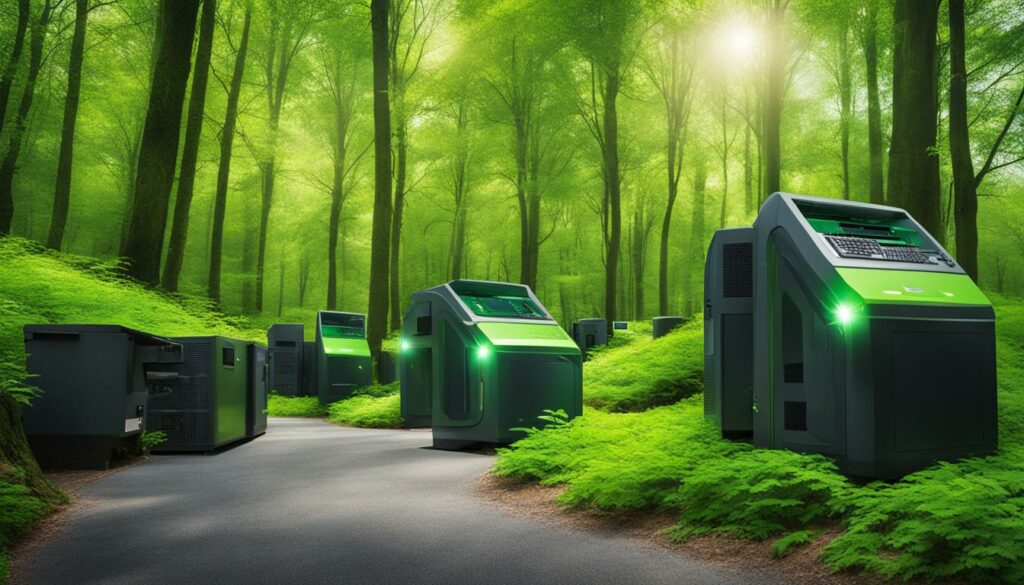
“Sustainable IT recycling is not just a buzzword; it is a necessity for a greener and more secure digital future.” – Tech Sustainability Magazine
These success stories serve as inspiration and demonstrate that sustainable IT recycling is possible and beneficial. Through collaboration and innovation, the IT industry can continue to develop more sustainable practices and reduce its environmental footprint. By adopting the examples set by tech companies, government initiatives, grassroots movements, and educational institutions, we can create a more sustainable and secure digital landscape for future generations.
The Future of IT Recycling in the Age of Cloud Computing
As the demand for cloud computing and data storage continues to grow, the future of IT recycling lies in implementing more sustainable practices. Advances in energy efficiency and renewable energy sources can reduce the environmental impact of data centers. Embracing the principles of the circular economy, such as reusing and recycling materials, can minimize waste and the need for new raw materials. Collaboration between different stakeholders, including governments, tech companies, and consumers, is essential in creating a more sustainable IT industry. The future of IT recycling is an opportunity for innovation and responsible stewardship of technology.
Key Principles for a Sustainable Future
- Energy Efficiency: Investing in energy-efficient infrastructure and technologies can significantly reduce the carbon footprint of data centers. This includes optimizing cooling systems, using energy-efficient hardware, and implementing smart power management systems.
- Circular Economy: Adopting a circular economy approach to IT recycling involves designing products with recyclability in mind, recovering valuable materials from end-of-life devices, and creating closed-loop systems that minimize waste and promote resource efficiency.
- Responsible E-waste Management: Proper e-waste management is crucial for minimizing the environmental impact of IT recycling. This involves implementing effective collection, recycling, and disposal processes to ensure that hazardous substances are properly handled and valuable materials are recovered.
- Education and Awareness: Educating individuals and businesses about the importance of sustainable IT practices is vital for driving change. Awareness campaigns can promote responsible electronics consumption, highlight the benefits of recycling, and encourage the adoption of greener technologies.
The Role of Collaboration
“Collaboration between governments, tech companies, and consumers is key to creating a sustainable IT industry. Governments can implement and enforce regulations that promote sustainable practices, while tech companies can innovate and develop eco-friendly solutions. Consumers play a crucial role by demanding greener technologies and supporting companies that prioritize sustainability.”
| Advantages of Sustainable IT Recycling | Challenges in Achieving a Sustainable Future |
|---|---|
| Reduces carbon emissions and environmental impact | Lack of awareness and understanding of sustainable practices |
| Conserves natural resources and reduces the need for new raw materials | High upfront costs of implementing sustainable technologies |
| Promotes a circular economy and reduces waste | Resistance to change from traditional IT recycling practices |
By embracing sustainable practices in IT recycling, we can create a more environmentally friendly and resource-efficient future. As technology continues to evolve, it is essential to prioritize sustainability and work together towards a greener and more secure digital landscape.
Conclusion
In conclusion, the rapid growth of cloud computing has brought about both benefits and environmental challenges. The disposal of data storage devices used in cloud computing contributes to electronic waste and carbon emissions, raising concerns about the environmental impact of the IT industry.
Secure data destruction practices are important to ensure data security, but there is a need to balance data protection with environmental sustainability. It is crucial for the IT industry to embrace sustainable practices throughout the lifecycle of data storage devices, from manufacturing to end-of-life management, to reduce the environmental footprint and promote a more sustainable future.
By incorporating these sustainable practices, such as energy-efficient usage, responsible recycling, and the principles of the circular economy, the IT industry can mitigate its environmental impact and contribute to a greener and more secure digital landscape. It is imperative for stakeholders, including governments, tech companies, and consumers, to collaborate and drive the adoption of these sustainable practices for a brighter future.
FAQ
What is the impact of cloud computing on IT recycling?
Cloud computing has contributed to the increase in electronic waste generated by the disposal of data storage devices.
Why is the disposal of data storage devices a concern?
Traditional practices such as shredding devices generate significant electronic waste and contribute to the carbon footprint of the IT industry.
Why do companies opt for the shredding of data storage devices?
Companies choose to shred devices to ensure data security and prevent potential data leakage.
Are there alternatives to shredding devices for data destruction?
Data wiping software can securely erase data from devices, but the fear of potential leaks and regulatory compliance often leads to the choice of physical destruction.
What are the environmental implications of data storage devices?
Throughout their lifecycle, data storage devices contribute to greenhouse gas emissions, pollution, and electronic waste generation.
How can sustainable practices be implemented in IT recycling?
Sustainable practices include energy-efficient manufacturing, green distribution channels, responsible end-of-life management, and the promotion of a circular economy.
Which organizations and institutions are leading the way in sustainable IT recycling?
Tech giants like Apple and Dell have committed to sustainable manufacturing practices, and government initiatives, grassroots movements, and educational institutions promote responsible computing.
What is the future of IT recycling in the age of cloud computing?
The future lies in implementing more sustainable practices, such as energy efficiency, circular economy principles, and collaboration between stakeholders.


